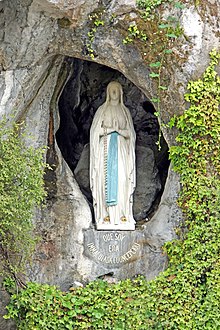
Back Itron Varia Lourd Breton Mare de Déu de Lorda Catalan Birhen sa Lourdes CEB Nuestra Señora de Lourdes Spanish Notre-Dame de Lourdes French Nosa Señora de Lourdes Galician Gospa Lurdska Croatian Bunda dari Lourdes ID Nostra Signora di Lourdes Italian Nossa Senhora de Lourdes Portuguese
| |
|---|---|
 The statue within the rock cave at Massabielle in Lourdes, where Saint Bernadette Soubirous witnessed the Blessed Virgin Mary | |
| Location | Lourdes, France |
| Date | 11 February to 16 July 1858 |
| Witness | Saint Bernadette Soubirous |
| Type | Marian apparition |
| Approval | Pope Pius IX (decree of approval of 1 February 1876) |
| Shrine | Sanctuary of Our Lady of Lourdes, Lourdes, France |
| Patronage | Lourdes, France, Quezon City, Tagaytay, Daegu, South Korea, Tennessee, Diocese of Lancaster, Lourdes School of Mandaluyong, bodily ills, sick people, asthmatics, protection from diseases |
| Feast day | 11 February |
Our Lady of Lourdes (French: Notre-Dame de Lourdes; Occitan: Nòstra Senhora de Lorda) is a title of the Virgin Mary. She is venerated under this title by the Roman Catholic Church due to her apparitions that occurred in Lourdes, France. The first apparition of 11 February 1858, of which Bernadette Soubirous (age 14) told her mother that a "Lady" spoke to her in the cave of Massabielle (1.5 kilometres (0.93 mi) from the town) while she was gathering firewood with her sister and a friend.[1] Similar apparitions of the "Lady" were reported on 18 occasions that year, until the climax revelation in which she introduced herself as: "the Immaculate Conception".[2] On 18 January 1862, the local Bishop of Tarbes Bertrand-Sévère Laurence endorsed the veneration of the Blessed Virgin Mary in Lourdes.
On 1 February 1876, Pope Pius IX officially granted a decree of canonical coronation to the image as Notre-Dame du Saint Rosaire. The coronation was performed by Cardinal Pier Francesco Meglia at the courtyard of what is now part of the Rosary Basilica on 3 July 1876.[3][4]
The image of Our Lady of Lourdes has been widely copied and reproduced in shrines and homes, often in garden landscapes. Bernadette Soubirous was canonized by Pope Pius XI in 1933.[5][6]
Marian devotion has since steadily increased as ecclesiastical investigations sanctioned her visions. In later years, a large church was built at the site that has since[7] become a major site of religious pilgrimage.
- ^ "Catholic Online: Apparitions of Our Lady of Lourdes First Apparition". Archived from the original on April 12, 2005.
- ^ 2009 Catholic Almanac. Our Sunday Visitor Publishing. 2009. ISBN 9781592764419.
- ^ "La Vierge couronnée – Lourdes". Archived from the original on 2014-09-05. Retrieved 2014-09-04.
- ^ ""Marie Reine, 22 août", Zenit, 21 Août 2013".
- ^ Burke, Raymond L.; et al. (2008). Mariology: A Guide for Priests, Deacons, Seminarians, and Consecrated Persons ISBN 978-1-57918-355-4 pp. 850–868
- ^ Lauretin, R., Lourdes, Dossier des documents authentiques, Paris: 1957
- ^ Buckley, James; Bauerschmidt, Frederick Christian, and Pomplun, Trent. The Blackwell Companion to Catholicism, 2010 ISBN 1444337327 p. 317